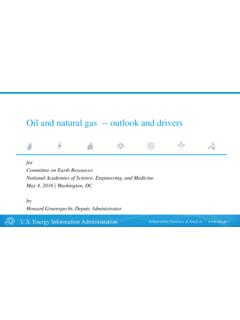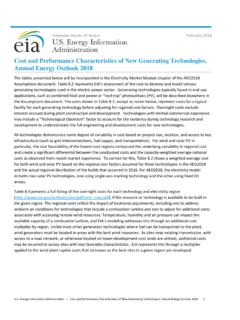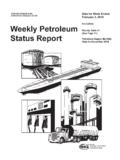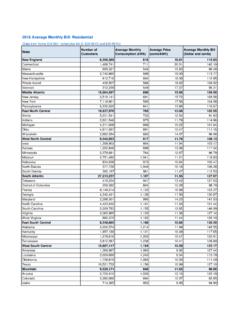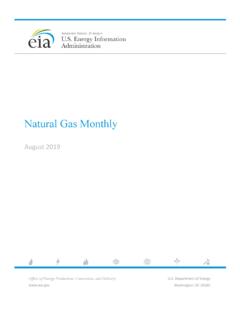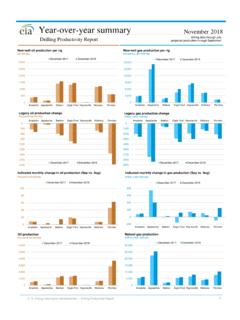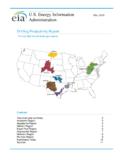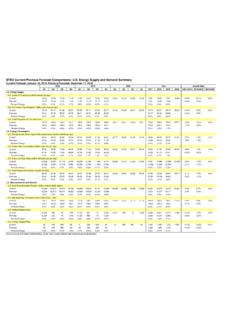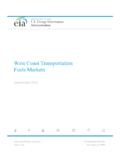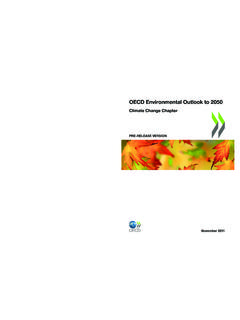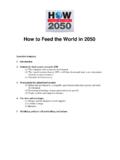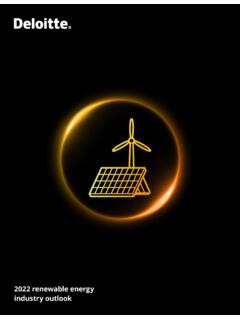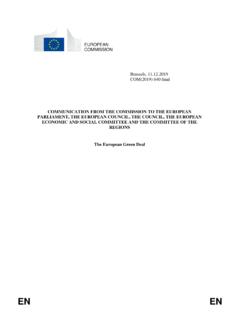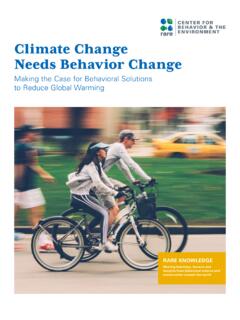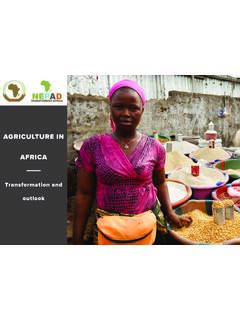Transcription of Summary of Legislation and Regulations Included in the ...
1 Summary of Legislation and Regulations Included in the Annual Energy Outlook 2022 March 2022 Independent Statistics & Analysis Department of Energy Washington, DC 20585 Energy Information Administration | Summary of Legislation and Regulations Included in the Annual Energy Outlook 2022 i This report was prepared by the Energy Information Administration (EIA), the statistical and analytical agency within the Department of Energy. By law, EIA s data, analyses, and forecasts are independent of approval by any other officer or employee of the Government. The views in this report therefore should not be construed as representing those of the Department of Energy or other federal 2022 Energy Information Administration | Summary of Legislation and Regulations Included in the Annual Energy Outlook 2022 ii The version of the National Energy Modeling System (NEMS) used for the Energy Information Administration s (EIA) Annual Energy Outlook 2022 (AEO2022) generally represents current Legislation , environmental Regulations , and international protocols, including recent government actions that had implementing Regulations as of the end of November 2021.
2 The potential effects of proposed federal and state Legislation , Regulations , or standards are not reflected in NEMS. In addition, NEMS does not reflect sections of Legislation that have been enacted but have not been funded or lack implementation Regulations . A list of the federal and selected state Legislation and Regulations Included in AEO2022, including how we incorporated them, is provided in each module s documentation. This document provides an overview of all the relevant Regulations and includes Summary tables that represent both new and existing Legislation and Regulations represented in NEMS. March 2022 Energy Information Administration | Summary of Legislation and Regulations Included in the Annual Energy Outlook 2022 iii Table of Contents New Laws and Regulations Reflected in the Reference case.
3 1 Federal .. 1 State .. 1 Existing Laws and Regulations Reflected in the Reference Case .. 1 Renewable portfolio standards .. 1 Delaware .. 7 Oregon .. 7 State energy efficiency resource standards and goals .. 7 Appendix A: Federal and Selected State Legislation and Regulations in the Annual Energy Outlook 2022 .. 11 March 2022 Energy Information Administration | Summary of Legislation and Regulations Included in the Annual Energy Outlook 2022 1 New Laws and Regulations Reflected in the Reference case Federal The Infrastructure Investment and Jobs Act was passed in November 2021, and we incorporated several of its provisions related to the energy sector in AEO2022. In the electric power sector, a civil nuclear credit program was established to support nuclear power plants that are struggling to remain economically viable in competitive electricity markets and are at risk of shut down.
4 A total of $6 billion is appropriated for fiscal years 2022 2026. State In 2021, Delaware and Oregon enacted new Legislation for their respective renewable portfolio standards (RPS) programs. Existing Laws and Regulations Reflected in the Reference Case The AEO2022 reflects a number of state-level policies that affect its projections of the electricity generation mix. The AEO2022 Reference case divides state Regulations into two general categories: state RPS and state energy efficiency programs. Renewable portfolio standards To the extent possible, the AEO2022 reflects state laws and Regulations enacted as of November 2021, that establish minimum requirements for renewable generation or capacity for utilities operating in the state.
5 These requirements represent known RPSs. The AEO2022 projections do not include laws and Regulations with either voluntary goals or targets that can be substantially satisfied with nonrenewable resources. The AEO2022 Reference case assumes that states will meet their RPS targets, yet it also assumes that states will not necessarily meet targets for interim years. We estimate RPS compliance constraints in most regions; however, because NEMS is not a state-level model, each state generally represents only a portion of one of the NEMS electricity regions. In general, we have confirmed the requirements for each state through original legislative or regulatory documentation, including the Database of State Incentives for Renewables & Efficiency (DSIRE).
6 Most states are meeting or exceeding their required levels of renewable generation, based on qualified generation or purchases of renewable energy A number of factors helped make RPS compliance attainable for generators, including: New RPS-qualified generation capacity timed to take advantage of federal incentives Lower cost of wind, solar, and other renewable technologies State and local policies that either reduce costs (for example, equipment rebates) or increase revenue streams (for example, net metering) associated with RPS-eligible technologies 1 G. Barbose, Renewables Portfolio Standards: 2017 Annual Status Report (Berkeley, CA: Lawrence Berkeley National Laboratory, July 2017).
7 March 2022 Energy Information Administration | Summary of Legislation and Regulations Included in the Annual Energy Outlook 2022 2 The RPS requirements for each state, as modeled for the AEO2022, are in Table 1. Table 1. Aggregate renewable portfolio standards requirements as modeled for AEO2022 State Target Qualifying renewables Qualifying other (thermal, efficiency, nonrenewable, distributed generation, etc.) Compliance mechanisms Arizona (AZ) 15% by 2025 Solar, wind, biomass, hydro, LFG, and anaerobic digestion built after January 1, 1997 Direct use of solar heat, ground-source heat pumps, renewable-fueled CHP, and fuel cells using renewable fuels Credit trading is allowed with some bundling restrictions.
8 Distributed generation is required, starting at 5% of target in 2007 and increasing to 30% by 2012 and after. California (CA) 60% electricity generation by 2030, 100% carbon-free by 2045 Geothermal electric, solar thermal electric, solar photovoltaics, wind (all), biomass, MSW, LFG, tidal, wave, ocean thermal, wind (small), hydroelectric (small), and anaerobic digestion Energy storage and fuel cells using renewable energy Nuclear and hydroelectric (large) qualify after 2030 toward the 100% carbon-free by 2045 target Credit trading is allowed with some restrictions. Renewable energy credit prices are capped at $50 per megawatthour (MWh). Colorado (CO) 30% by 2020 for investor-owned utilities, 20% by 2020 for large electric cooperatives, 10% by 2020 for other cooperatives and municipal utilities serving more than 40,000 customers Solar, wind, biomass, hydro, and geothermal Recycled energy, coal-mine methane, pyrolysis gas produced from MSW, and fuel cells Credit trading is allowed.
9 Renewable distributed generation requirement applies to investor-owned utilities (3% of sales by 2020) and electric cooperatives ( or 1% of sales by 2020, depending on size). Generation is eligible to earn credit multipliers if it is associated with certain projects that have specific ownership or transmission ties with small utilities, entities, or individuals. Connecticut (CT) 48% by 2030 (44% renewables, 4% efficiency and CHP) Solar, wind, biomass, hydro (with exceptions), geothermal, LFG/MSW, anaerobic digestion, and marine CHP and fuel cells Credit trading is allowed. Obligated providers may comply through an alternative compliance payment of $55/MWh. The target is composed of three class tiers that have tier-specific targets.
10 District of Columbia (DC) 100% by 2040 Solar, wind, biomass, hydro, geothermal, LFG/MSW, and marine Direct use of solar and cofiring Credit trading is allowed. The target includes a solar-specific set-aside equivalent to of sales by 2023. Obligated providers may also comply through a tier-specific alternative compliance payment. Delaware (DE) 40% by 2035 Solar, wind, biomass, hydro, geothermal, LFG, anaerobic digestion, and marine Fuel cells Credit trading is allowed. Credit multipliers are awarded for several compliance specifications, including a 300% credit awarded for generation from in-state distributed solar and renewable-fueled fuel cells. Target increases for some suppliers can be subject to a cost threshold.
